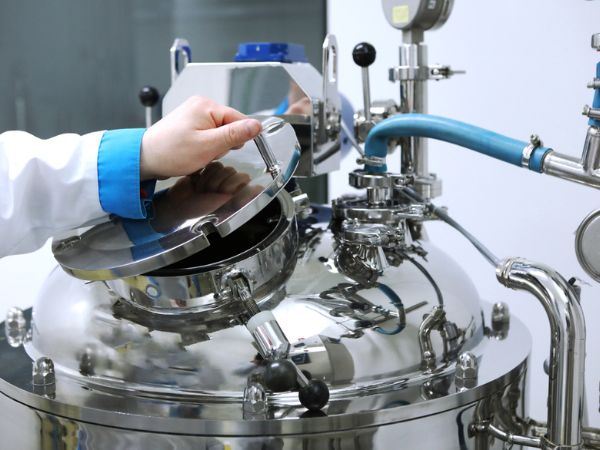Drying can be critical in chemical manufacturing, especially in fine chemical process industries. The process is deceptively complex. It involves simultaneous heat and mass transfer, which can influence end-product qualities enormously. Yet, there is a significant difference between the drying methodologies for fine and heavy chemicals.
Fine chemicals are so sensitive that advanced drying techniques are often needed to preserve their essential qualities. Heavy chemicals, meanwhile, often bypass drying altogether, relying on production methods like distillation or crystallisation. Let’s discuss those differences in more depth.

Drying in Fine Chemicals
Fine chemicals are high-value chemicals used in specialised applications like pharmaceuticals, agrochemicals, and biotechnology. As such, they are typically produced in small quantities. The drying process in fine chemicals is crucial for several reasons:
- Moisture Content Removal: Essential for stability and shelf-life.
- Purity and Quality Control: Critical in applications like pharmaceuticals.
- Material Characteristics: Influences physical properties like particle size and morphology.
Recent research highlights various drying methods employed in fine chemical production:
- Convective Drying: Often used for its simplicity and efficiency. Studies have modelled convective drying of materials like pineapple slices, showing how moisture migration and shrinkage are crucial factors.
- Heat Pump Drying: Used for its energy efficiency and ability to maintain quality. For example, cocoa bean drying kinetics during heat pump drying have been extensively studied.
- Spray Drying: Popular for producing powders from liquid solutions, offering control over particle size and distribution.
- Freeze Drying: Used for heat-sensitive chemicals, preserving their structural integrity and prolonging shelf-life.
Drying in Heavy Chemicals
Heavy chemicals, in contrast, are typically bulk raw materials produced in large quantities and used in products like fertilisers, petrochemicals, and plastics. The production of heavy chemicals often involves:
- Distillation: Separates components based on differences in boiling points.
- Crystallization: Used for purifying solid compounds.
- Precipitation: For separating compounds from a solution.
Drying is not a primary process in heavy chemicals production due to the nature of the products and the scale of operation. Heavy chemicals include acids, alkalis, and salts. The production methods for these chemicals often involve phase changes that reduce moisture content, while the nature of heavy chemicals places less emphasis on purity and QC than with fine chemicals. That said, heavy chemical drying can still play an important role in the pipeline.
The large-scale nature of heavy chemical production favours less intricate processes than the precision required in drying fine chemicals, where even minor variations can significantly impact product quality. Thus, heavy chemicals may be suitably dried using conventional drying agents. Large scale mechanical drying methods like cake filtration and sedimentation may also be used where appropriate.
Technological Innovations
Technological advancements in drying processes have led to more efficient and sustainable methods. For example, the reaction engineering approach (REA) models the drying process by establishing the apparent activation energy of the material, providing a unique fingerprint of its drying behaviour. This approach can optimise drying conditions, thus enhancing efficiency and quality. Other innovations, particularly in the realm of fine chemical manufacturing, include filter drying technology.
Filter dryers are instrumental in separating solids from liquids, facilitating the drying of wet materials under controlled conditions. This is particularly vital in the pharmaceutical industry, where drying wet cake or slurry requires precision to maintain product integrity.
Enhanced Moisture Removal: Filter dryers enable efficient moisture removal under vacuum or pressurised conditions, which is crucial for product stability. The presence of an agitator enables gentle mixing which removes layer variance and provides uniform batch drying throughout the batch.
Solvent Separation: They are adept at separating solvents from the product, ensuring purity and reducing contamination risks. This also contributes to better drying efficiency and a higher quality product, as it can be washed in the filter dryer using various solvents that are easier to evaporate.
Controlled Drying Conditions: Filter dryers offer precise control over drying parameters, significantly impacting product quality. Adjusting temperature, pressure, and duration can tailor the drying process to specific material requirements.
Material Integrity: Particularly in pharmaceuticals, maintaining the structural and chemical integrity of the product during drying is critical. Filter dryers achieve this by gentle handling of delicate substances. The agitator operates at very low RPM, meaning there’s little shear or heat generation – further enhancing batch uniformity.
Energy Efficiency: Modern filter dryers are designed for energy efficiency, reducing operational costs and environmental impact. Optimised heating zones, such as heated agitation technology, is also crucial for energy efficiency as it allows for direct product heat exchange.
Interested in Fine Chemicals Drying Solutions?
Drying is pivotal in fine chemicals production but less significant in heavy chemical manufacturing. Innovations in drying technology continue to enhance efficiency and product quality, which is vital for industries relying on fine chemicals. Powder Systems Ltd., with our expertise in filter dryer systems, is well-positioned to leverage these advancements, offering optimised solutions for the drying needs of fine chemicals.
